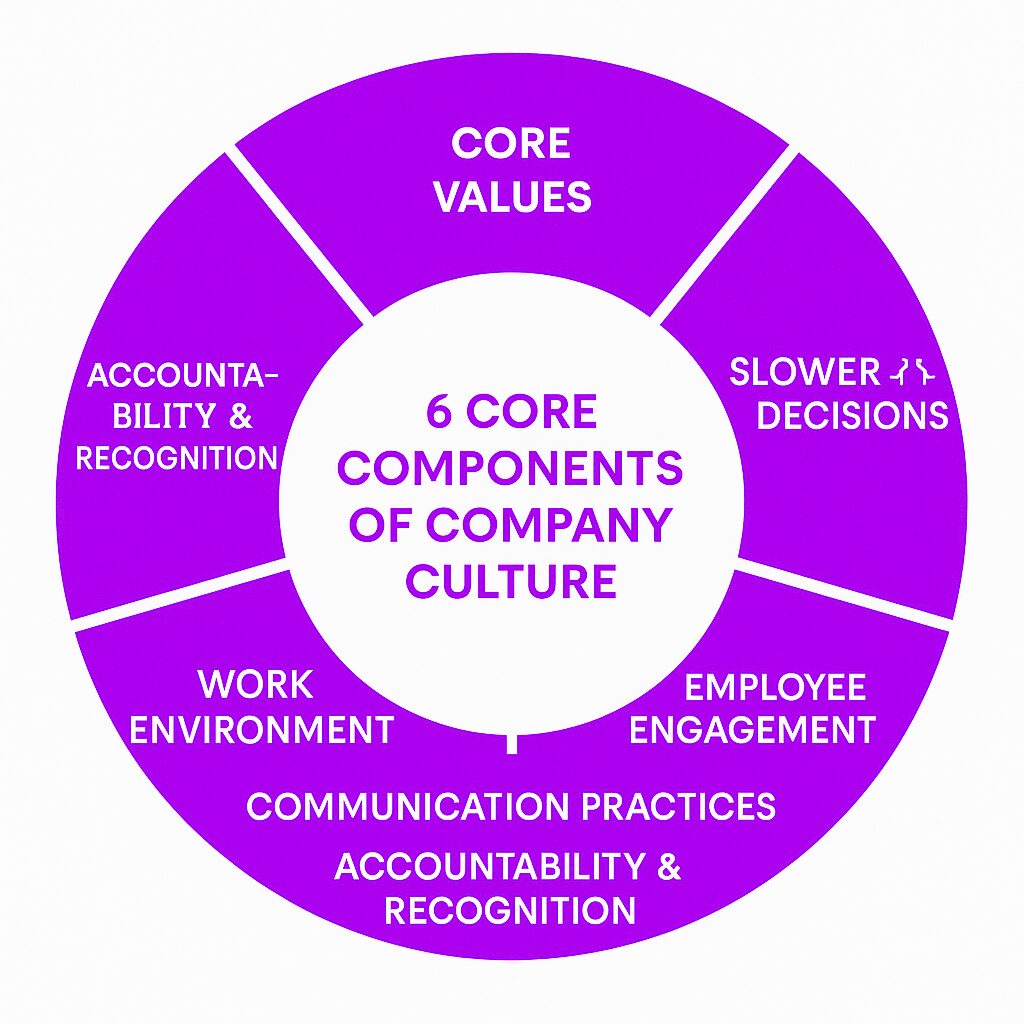What Is Company Culture?
Company culture refers to the shared values, behaviors, and work environment that define an organization. It shapes how employees interact, make decisions, and contribute to business goals. Culture is often reflected in leadership style, company policies, communication methods, and workplace traditions. Unlike perks such as free snacks or gym memberships, culture is deeply ingrained in how a company operates.
A strong corporate culture creates a sense of identity, fosters employee engagement, and impacts overall business success. Organizations with positive cultures attract top talent, improve retention, and boost productivity. A poor company culture, on the other hand, leads to disengagement, high turnover, and inefficiencies in the workplace.
Key Components of Company Culture
1. Core Values
Core values are the fundamental beliefs that guide a company’s actions and decision-making. They shape the organizational culture by setting the standard for workplace behavior and interactions.
2. Leadership Style
Leadership plays a crucial role in shaping culture. The way executives communicate, recognize employees, and handle challenges influences the overall work environment.
3. Work Environment
The physical and emotional environment in which employees operate affects morale and productivity. Factors such as office layout, remote work policies, and collaboration tools contribute to workplace culture.
4. Employee Engagement
A company’s culture determines how engaged employees feel in their roles. Organizations that prioritize engagement and mutual respect see higher job satisfaction and performance levels.
5. Communication Practices
Transparency and open communication foster trust and alignment across teams. Companies that encourage honest feedback, regular check-ins, and mutual respect contribute to a great company culture, creating a culture of collaboration.
6. Accountability and Recognition
Employees perform better when they know their contributions matter. Recognizing achievements and setting clear expectations reinforce positive behaviors.
The Benefits of a Strong Company Culture
A strong company culture offers numerous advantages that can significantly impact an organization’s success. Here are some key benefits:
-
Increased Employee Engagement: A positive company culture fosters higher employee engagement, which is crucial for driving business success. Engaged employees are more productive, motivated, and committed to their work.
-
Improved Employee Retention: A strong company culture helps reduce turnover rates and enhances employee retention. When employees feel valued and supported, they are more likely to stay with the organization long-term.
-
Enhanced Reputation: A positive company culture boosts an organization’s reputation, making it more attractive to top talent. It also leads to positive word-of-mouth and favorable online reviews.
-
Increased Productivity: A healthy culture leads to increased productivity and efficiency. When employees feel supported and motivated, they are more likely to deliver high-quality work.
-
Better Decision Making: A strong company culture promotes better decision making. Empowered and supported employees are more likely to make decisions that align with the organization’s values and goals.
-
Improved Customer Satisfaction: A positive company culture enhances customer satisfaction. Engaged and motivated employees are more likely to provide excellent customer service.
-
Increased Innovation: A strong company culture encourages innovation. When employees feel supported and empowered, they are more likely to think creatively and generate new ideas.
Why Company Culture Matters
1. Defines Internal and External Identity
Company culture influences how employees interact internally and how the brand is perceived externally. A strong culture reflects consistency in values and business operations.
2. Attracts and Retains Talent
Candidates prioritize workplace culture when choosing a job. An organization’s culture plays a crucial role in employee retention and overall workplace dynamics, leading to lower turnover and greater employee satisfaction.
3. Boosts Employee Advocacy
Employees who align with company culture become advocates for the organization. They promote the brand and contribute to a positive workplace reputation.
4. Improves Productivity
When employees feel connected to their work environment, they are more engaged, motivated, and productive.
Types of Company Culture
1. Collaborative Culture
This type of culture focuses on teamwork, transparency, and employee input. Companies with a collaborative culture encourage open discussions and shared decision-making.
2. Adhocracy Culture
An innovation-driven culture that values creativity, risk-taking, and adaptability. Startups and tech companies often thrive under this model.
3. Market Culture
A results-driven culture focused on achieving goals, competition, and performance metrics. Organizations with this culture emphasize strategic objectives and measurable outcomes.
4. Hierarchy Culture
A structured culture with defined roles, policies, and processes. It prioritizes stability, consistency, and clear authority lines.
Challenges of Company Culture
1. Leadership Misalignment
If leadership does not embody company values, credibility and employee trust decline.
2. Resistance to Change
Shifting company culture can be difficult, especially if employees are used to a different way of working.
3. Poor Communication
Lack of transparency can lead to confusion, disengagement, and distrust among employees, contributing to a toxic company culture where negativity prevails and employees feel unsafe or undervalued.
4. Diversity and Inclusion Gaps
A failure to create an inclusive environment can result in disengagement and high turnover.
5. Work-Life Balance Issues
Cultures that emphasize constant work over employee well-being contribute to burnout and dissatisfaction.
How to Build a Strong Company Culture
1. Define and Communicate Core Values
Establish clear, actionable values that guide company behavior. Reinforce them in company messaging and leadership actions.
2. Lead by Example
Executives and managers should model the behaviors they expect from employees.
3. Foster Open Communication
Encourage transparency, feedback, and discussions to create a culture of trust. Emphasize the importance of team members engaging in healthy debates and addressing disagreements to foster open communication and collaboration.
4. Promote Teamwork and Inclusion
A collaborative and diverse work environment, where each team member is encouraged to engage in healthy debates and communicate openly, leads to stronger engagement and performance.
5. Invest in Employee Growth
Professional development opportunities, mentorship programs, and career growth paths contribute to a positive culture.
6. Recognize Employee Contributions
Acknowledging and rewarding achievements helps reinforce company values and boosts motivation.
7. Establish a Culture Committee
Establishing a culture committee is an effective way to promote and maintain a positive company culture. A culture committee can:
-
Develop and implement cultural initiatives
-
Promote company values and mission
-
Foster a sense of community and teamwork
-
Recognize and reward employees for their contributions
-
Provide feedback and suggestions for improving the culture
A culture committee should include employees from various departments and levels within the organization. This ensures that all voices are heard and that the committee represents the organization as a whole.
Assessing and Improving Company Culture
Assessing and improving company culture is an ongoing process that requires effort and commitment from all levels of the organization. Here are some steps to assess and improve company culture:
-
Conduct Employee Surveys: Regular employee surveys can help identify areas of strength and weakness in the company culture.
-
Gather Feedback: Collect feedback from employees, customers, and other stakeholders to identify areas for improvement.
-
Develop a Culture Strategy: Create a culture strategy that aligns the organization’s values and mission with its goals and objectives.
-
Provide Training and Development: Offer training and development opportunities to support employees in their roles and promote a culture of continuous learning.
-
Recognize and Reward Employees: Acknowledge and reward employees for their contributions to promote a positive company culture and motivate employees to perform at their best.
-
Lead by Example: Leaders and managers should model the behaviors and values they expect from their employees.
-
Monitor Progress: Continuously monitor progress and make adjustments as needed to ensure the company culture aligns with the organization’s goals and objectives.
By following these steps, organizations can assess and improve their company culture, leading to increased employee engagement, retention, and productivity, as well as improved customer satisfaction and business success.
Real-World Examples of Strong Company Culture
1. SecureLink
SecureLink prioritizes diversity and inclusion by hiring employees from various backgrounds, ensuring a broad range of perspectives in the workplace.
2. Alphabet Inc. (Google’s Parent Company)
Alphabet promotes creativity, innovation, and flexible work environments. Their emphasis on professional growth results in high employee satisfaction.
3. Amazon
Amazon’s culture focuses on customer obsession, operational excellence, and long-term thinking. Employees thrive in its high-intensity, results-driven environment.
The Future of Company Culture
As work environments evolve, company culture will continue to play a critical role in business success. Organizations that prioritize employee well-being, remote work flexibility, and continuous learning will build resilient cultures that attract and retain top talent. The key to a strong culture lies in leadership alignment, open communication, and embedding core values into everyday business practices.







